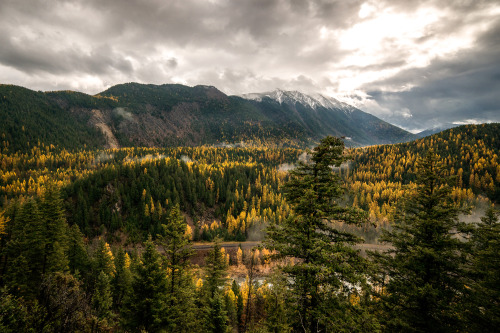


If you’ve visited northwest Montana in the fall, you’ve likely heard the following… “Are the larch starting to turn?” “I thought for sure the larch would be turning by now.” “The larch are going OFF right now!”
The autumn color change of Western larch trees is a highly anticipated event here. Larix occidentalis, the Western larch, is the largest of its species. It can reach heights of over 150 feet and live to be over 500 years old. It’s known for turning a luminescent yellow in the fall, lighting up slopes in golden patches.
Western larch needles change color as the days grow shorter and temperatures drop. Conducting photosynthesis becomes more difficult, so the tree saves nutrients by ceasing the process. The needles’ color changes because chlorophyll (the light-absorbing pigment that provides energy for photosynthesis) is absorbed back into the tree, leaving behind a yellow pigment, xanthophyll. Eventually the needles will drop off the tree, leaving it bare-limbed until spring.
Beyond their stunning fall colors, Western larch are unique for many other reasons. Boreal and subalpine forests in northern states are typically distinguished by evergreen trees. Evergreen trees (like Douglas fir and lodgepole pine) use nutrients conservatively, allowing them to survive long, cold winters and short summers. So, how does a deciduous conifer like the Western larch thrive in these places that seem so suited to evergreens?
Larches may have learned to mimic evergreen conifers in order to survive. Their conical canopy structure, needle shape, and water transport systems closely resemble those of evergreen conifers. Larches, however, save energy and avoid winter damage to their foliage by dropping their needles. This helps them grow tall and compete with other conifers.
Larches have also evolved to succeed with wildfire. They have thick bark low in resin, helping them resist ground fires. They shed their bottom branches as they grow and have high canopies, so they can avoid crown fires as well. Their winged seedlings spread easily in the wind and grow quickly in the mineral-rich soils of scorched ground. Mature larches are often the only trees left standing after a wildfire.
The Western larch provides important food and shelter for wildlife. Several studies have documented its importance to pileated woodpeckers, who prefer it to other trees for nesting and foraging. Many other birds, rodents, and small mammals will feed on and nest in both living and dead larch trees.
The larch in the park are nearing their golden peak, treating us to a brilliant display before winter sets in with a beauty all its own.
[Image descriptions: Top photo: Valley of evergreen trees interspersed with bright yellow conifers with dramatic mountain scenery and clouds in the background. Middle photo: Low-angle shot of a tall tree with bright yellow needles. Bottom photo: Closeup of golden larch trees among green pines]
Sources:
Bellis, Natasha. “Golden Islands Of The Western Montana Forest.” MTPR, Montana Public Radio, 8 Oct. 2017, www.mtpr.org/post/golden-islands-western-montana-forest
Gower, Stith T., and James H. Richards. “Larches: Deciduous Conifers in an Evergreen World.” BioScience, vol. 40, no. 11, 1990, pp. 818–826. JSTOR, www.jstor.org/stable/1311484.
McClelland, B. Riley, and Patricia T. McClelland. “Pileated Woodpecker Nest and Roost Trees in Montana: Links with Old-Growth and Forest ‘Health.’” Wildlife Society Bulletin (1973-2006), vol. 27, no. 3, 1999, pp. 846–857. JSTOR, www.jstor.org/stable/3784108.
Micken, Lori. “Western Larch.” Montana Fish, Wildlife & Parks, fwp.mt.gov/mtoutdoors/HTML/articles/portraits/tamarack.htm
Scher, Janette S. “Larix occidentalis.” Fire Effects Information System, U.S. Forest Service, Rocky Mountain Research Station, Fire Sciences Laboratory, 2002. https://www.fs.fed.us/database/feis/plants/tree/larlya/all.html
jakobslock liked this
a-lc01 liked this
outdooradventure7 liked this
 rivermusic liked this
rivermusic liked this montaralin liked this
 sumbluespruce liked this
sumbluespruce liked this romanpolaroid liked this
midnightthefat liked this
maya-hiegger liked this
crazy4orcas liked this
himynamesbrandon reblogged this from antarcticajoy
himynamesbrandon liked this
 swordsagedachsie liked this
swordsagedachsie liked this motherofbirbs reblogged this from eregyrn-falls
motherofbirbs liked this
your-sweet-anatomy liked this
kaznata reblogged this from eregyrn-falls
kaznata liked this
 ball-lightning reblogged this from eregyrn-falls
ball-lightning reblogged this from eregyrn-falls  ball-lightning liked this
ball-lightning liked this guilty-pleasures-abound liked this
willowworbler reblogged this from eregyrn-falls
dragonsmirk reblogged this from eregyrn-falls
dragonsmirk liked this
eregyrn-falls reblogged this from glaciernps
swagg-s0-official reblogged this from glaciernps
eregyrn-falls liked this
 flowers-and-arson reblogged this from swiggity-swoosername-no-username
flowers-and-arson reblogged this from swiggity-swoosername-no-username bwwhitney liked this
freddiedeboer liked this
 squirrelsrunwild reblogged this from glaciernps
squirrelsrunwild reblogged this from glaciernps parkbombiscool liked this
swiggity-swoosername-no-username reblogged this from dannysneksbang
swiggity-swoosername-no-username liked this
 0non-bee-nary0 liked this
0non-bee-nary0 liked this dannysneksbang liked this
the-snowybutch reblogged this from glaciernps
the-snowybutch liked this
 squirrelsrunwild liked this
squirrelsrunwild liked this antarcticajoy reblogged this from glaciernps
glaciernps posted this
- Show more notes
